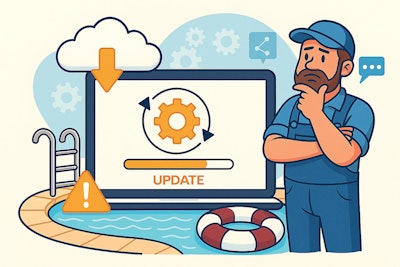
You know the drill: you bought your current software system years ago, installed it throughout your company and trained your employees on it. Everyone’s comfortable, even with some of its quirks.
But as time goes on, you might not see the signs that it’s time to upgrade. Is the small issue you’re experiencing a temporary pain point that can be assuaged, or has your business simply outgrown the whole system? We spoke to two leading software companies — Skimmer and RB Retail & Service Solutions — to recognize the signs and understand the risks of using outdated software.
“If your current software looks like it was developed in the 1980s, imagine what’s underneath the hood!” quips Niki Acosta, director of marketing at Skimmer. “In all seriousness, some of the first red flags to look for are when your team isn’t really using the system the way it’s intended, or when you start relying on workarounds. If you’re constantly exporting data to spreadsheets, using separate apps to fill in gaps, or falling back on older systems ‘just to get it done,’ that’s a sign your software isn’t keeping up with the business.”
These red flags can leave you vulnerable to a number of risks, RB’s vice president, Rachael Pritz, says. “It’s really important for business owners to understand the security risks that come with using software that’s no longer being supported or working for them. Risks that sometimes, if you’re storing credit card information, can come with a pretty hefty price tag.”
Outside of security liabilities, Acosta highlights revenue loss, service delays and missed appointments as other software hazards you’ll want to avoid at all costs.
“When you’re working off outdated systems, it’s easy for things to fall through the cracks — missed charges for parts, forgotten filter cleans, and chemicals that never make it onto an invoice. That adds up fast.
“In risking service delays and missed appointments, you could be frustrating customers and that leads to cancellations, which doesn’t just lose customers — it damages your reputation. In this industry, word-of- mouth matters.”
But how do you differentiate between a temporary pain point and a sign that it’s truly time to upgrade?
“If it’s costing your business money,” Pritz says. “Even referring to your staff, asking them what they’d like to see in a software system can help. What would make their jobs easier? They’re the ones doing the work, so if there’s a way to make their job easier that transcends your current system, that’s a great indicator that you should upgrade.”
One of the easiest ways to minimize risk, Pritz advises, is to pay for the updates to the current software system that you’re using. This way, you won’t have to re-learn an entirely new system and hopefully get used to the new tricks and quirks that the updated version offers.
On the other hand, Acosta lists a few examples that can help you figure out if abandoning your old software and looking to something completely new is your best choice:
- Increasing Manual Admin Work: If you’re still manually entering work orders, sending invoices, or tracking chemicals on paper, your software isn’t doing enough heavy lifting.
- Losing Revenue Opportunities: Missed filter cleans, forgotten upsells, or no way to track billable extras equals money left on the table. That’s a systems failure, not a human one.
- Lacking Team Visibility: If you can’t easily see what’s been done, where your techs are, or which pools were skipped, you’re flying blind.
- Not Built for Your Scale: If you’re juggling multiple routes, dozens of techs, or thousands of pools, and your software feels like it’s buckling under the weight — that’s a hard stop.
- Your Techs Avoid It: 150-plus features won’t do you any good if your field team avoids using the app. If your techs can’t or won’t use the tools you provide, that hurts service quality and accountability.
- Frustrated Customers: If customers are calling about invoices, confused about scheduling, or can’t pay online, that’s a sign your software is failing to deliver a modern customer experience.
It sounds daunting, especially if any of the aforementioned signs apply to your business. But industry-specific software companies can make the transition smoother, often offering customer support and one-on-one training sessions for those who are learning a brand new system.
The choice to upgrade should be one taken seriously, but as both Acosta and Pritz emphasize, it shouldn’t scare you. Evaluate your current system and how it’s serving you, and see for yourself if an upgrade is in the cards.
This article first appeared in the August 2025 issue of AQUA Magazine — the top resource for retailers, builders and service pros in the pool and spa industry. Subscriptions to the print magazine are free to all industry professionals. Click here to subscribe.




































